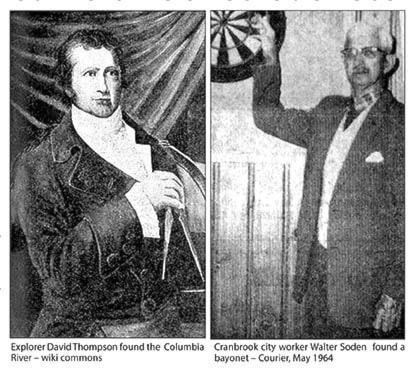Jim Cameron
In September, 1928, Walter Soden of the city works department, while excavating along the two city blocks that constituted Pooley (15th) Avenue at the time, reached down into a two foot hole and pulled up a very old bayonet; a knife -like-weapon designed to fit on the end of a rifle for use during close combat. The Cranbrook Herald, commenting on the discovery, stated, "Examined later by an expert, an officer of the RCMP, the weapon was believed to be of French manufacture and, as nearly as he could judge, 220 years old. The relic, which is now in possession of W.S. Santo, [president of the Cranbrook Board of Trade at the time] is fairly well preserved though it is obvious that it has lain underground for many years."
Almost exactly 30 years earlier, in October, 1898, men engaged in digging the foundation for the Thomas Leask building on Baker Street also made a surprising find. About three or four feet down in the solid ground was a "loaf of cake" crusted with dirt but "in a most excellent state of preservation." How it came to be there was unknown although the popular consensus, according to the Herald was that "...a party may have camped on the spot sometime in the past, as there is a spring at hand. A hole may have been dug for baking and the loaf accidentally left behind and gradually buried to the depth it was found."
It is worth noting that, aside from the fact that objects of historical interest are often found in holes in the ground, although the rise of Cranbrook as a city may be directly attributed to the coming of the railway in 1898, the people of Cranbrook were not the first ones here. Not exactly news, of course. In the East Kootenay that particular claim belongs to the members of the native Ktunaxa tribe who, according to their (much abridged, in this case) Creation Story, are descended from a water monster by the name of Yawu?nik' who, in ancestral times, created much trouble while plying the local waterways. A war party of animals including Wasa (horse-tail) and Mayuk (weasel) was formed and chased the monster along the Kootenay and Columbia rivers (which were joined at the time) in an endless circle until a wise old animal watching the proceedings suggested trapping Yawu?nik' in Columbia Lake. Good idea. Once trapped the monster was killed by a red-headed woodpecker, dragged ashore and chopped into small bits by the Chief animal who crumbled Yawu?nik's white swim bladder and scattered the pieces to form the race of white people, the kidney to form the black, the orange roe to form the yellow and the blood to form the red race who then became keepers of the land.
An opposing theory is that the red colour may have simply hiked over the Rockies from Alberta and settled down centuries earlier. Take your pick.
If we go with Yawu?nik', he apparently gave all but the red people a pretty good toss as they all had to come back quite some distance to settle in the Kootenays in years to come. Certainly the other colours made their way here by the time of the Wild Horse Gold Rush of 1864. No doubt this influx or those following afterwards may suitably account for the buried cake loaf.
The bayonet, on the other hand, presents a somewhat more intriguing mystery. Was it truly a French bayonet, perhaps left behind by one of the fur trappers who may have traversed the area in the 18th century, perhaps traveling alongside adjacent Joseph Creek? Or was it simply a Swiss Army Knife of its day, lost by some miner headed to the goldfields who cursed his luck the next time he tried to open his canned beans? The answer will likely never be known as both the bayonet and the loaf of cake appear to have long since vanished.
Speaking of relics, during the Cranbrook Pioneer Reunion of September, 1938, Mrs. Paterson, a long-time resident of Cranbrook, brought out a family heirloom: the watch carried 140 years earlier by David Thompson, to indicate when to fire the noon cannon in the town of York (Toronto). Manufactured by David Lewis of London in 1729, the watch likely passed through several hands before being brought to York in 1796 by Mr. Thompson and eventually ending up in Cranbrook.
It was, if one may mingle accounts, the little white scattered crumble of the monster's bladder David Thompson who first came this way with both a desire to create maps and a mission to find the mighty Columbia River which he located it in 1807 and promptly named the Kootenay. In due time the error was discovered and the river he previously named "MacGillivray's," became the present day Kootenay.
The French of the day generally referred to the Kootenay River as the "Arc Plat" (Flat Bow) in reference to the flat bows used by the local natives. The French rarely, if ever, named things in English which often meant a general re-naming of things once the English arrived.
Actually, throughout North America, a whole lot of French and Native place names weren't actually renamed but rather bastardized into something resembling English, which is why, the word "Kootenay," appears as Kutenai (French), Kootenae (Thompson's Gaelic preference), Kootenai, Kutenay, Kootenie, Cootnahews (explorer Alexander Mackenzie), Cotton-na-hews (explorer Peter Fidler) and various other permutations all interpreted from either "Ktunaxa" or sources unknown, depending on who is doing the telling.
And so, the bayonet near Joseph Creek, the cake loaf near a downtown spring, Yawu?nik' in the lake and Thompson on the river all tell of water. The rivers, streams and lakes of the Columbia Basin, the lifeblood of the Kootenays long before the roads and rails sliced through.
Next week: The Kootenay River and the dreamers who steamed her.
